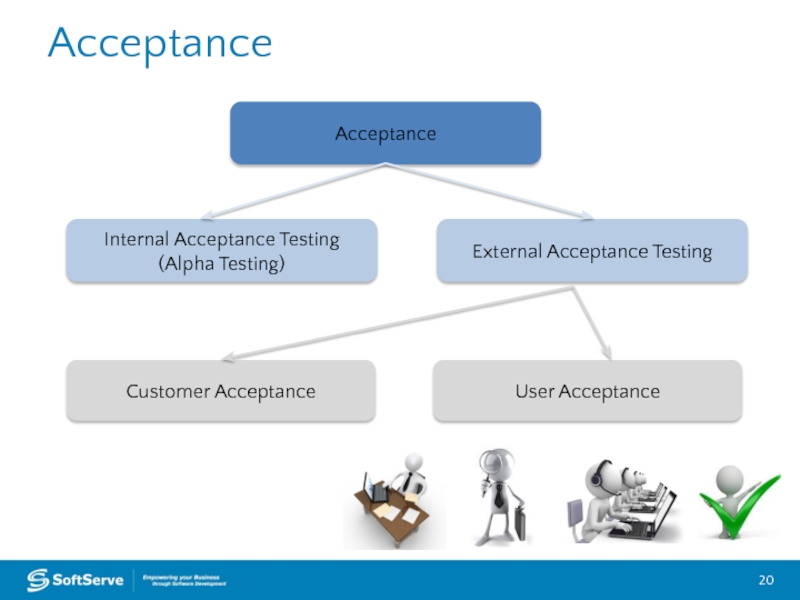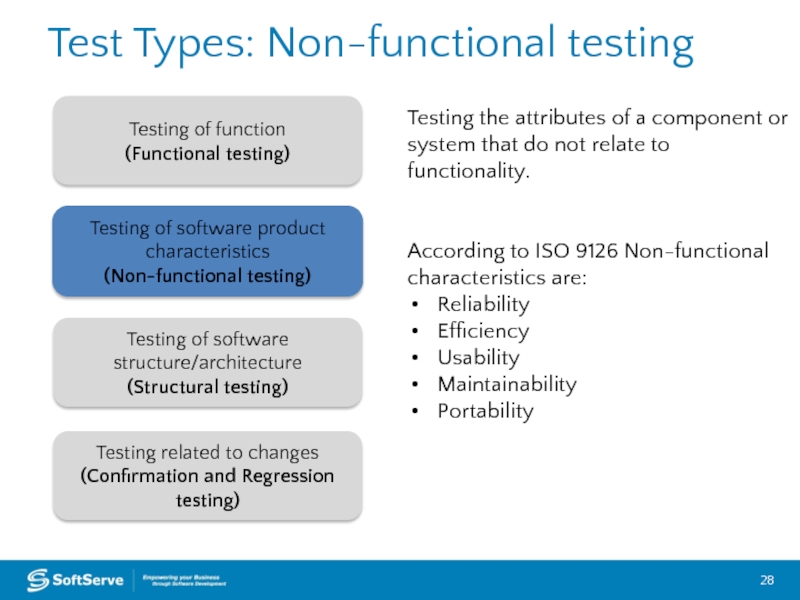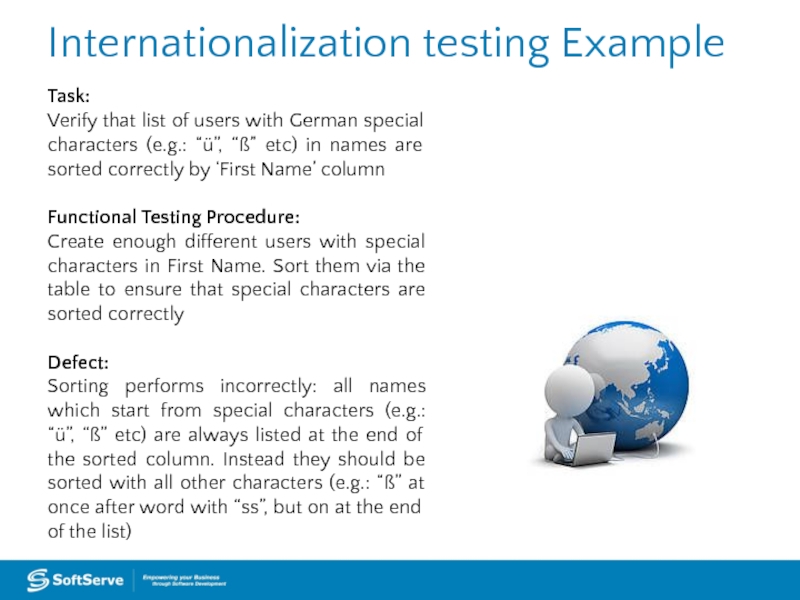- Главная
- Разное
- Дизайн
- Бизнес и предпринимательство
- Аналитика
- Образование
- Развлечения
- Красота и здоровье
- Финансы
- Государство
- Путешествия
- Спорт
- Недвижимость
- Армия
- Графика
- Культурология
- Еда и кулинария
- Лингвистика
- Английский язык
- Астрономия
- Алгебра
- Биология
- География
- Детские презентации
- Информатика
- История
- Литература
- Маркетинг
- Математика
- Медицина
- Менеджмент
- Музыка
- МХК
- Немецкий язык
- ОБЖ
- Обществознание
- Окружающий мир
- Педагогика
- Русский язык
- Технология
- Физика
- Философия
- Химия
- Шаблоны, картинки для презентаций
- Экология
- Экономика
- Юриспруденция
Test approaches, levels, types презентация
Содержание
- 1. Test approaches, levels, types
- 2. Agenda Test Approaches Test Types by Test Levels Test Types by Test Objectives Testing Order
- 3. Test Types Acceptance Load Compatibility Functional Black
- 4. Test Type Definition Test Type it’s a
- 5. Test Approaches
- 6. Test Approaches Proactive and Reactive Manual and
- 7. Reactive behavior is reacting to problems when
- 8. Manual and Automated Manual testing is the
- 9. Verification and Validation To ensure that
- 10. Positive and Negative In positive testing
- 11. Black-box, White-box, Grey-box Black-box Testing is a
- 12. Scripted and Unscripted Test execution carried out
- 13. Unscripted testing An informal test design technique
- 14. Test Types by Test Levels
- 15. Test Levels
- 16. Component Component (Unit) Integration System Acceptance Testing
- 17. Integration Integration Component (Unit) System Acceptance Testing
- 18. System System Integration Component (Unit) Acceptance
- 19. Acceptance Acceptance Integration System Component (Unit) Testing
- 20. Acceptance Acceptance Internal Acceptance Testing (Alpha Testing) External Acceptance Testing Customer Acceptance User Acceptance
- 21. Test Types by Test Objectives
- 22. What it does? Test Types Depending on
- 23. Test Types: Functional testing Testing of function
- 24. Functional testing Suitability: the capability to provide
- 25. Functional testing Example Task: Test Save feature
- 26. Functional testing: Smoke A subset of all
- 27. Smoke testing Example Task: Test new version
- 28. Test Types: Non-functional testing Testing of function
- 29. Non-functional testing • Reliability: maturity (robustness), fault-tolerance,
- 30. Non-functional testing: UI UI Testing: The testing
- 31. Non-functional testing: Performance Performance Testing: Testing with
- 32. Performance testing Example Task: Server should respond
- 33. Non-functional testing: Load Load testing is a
- 34. Load testing Example Task: Server should allow
- 35. Non-functional testing: Stress Stress testing: A type
- 36. Stress testing Example Task: Server should allow
- 37. Non-functional testing: L10N, I18N Localization is the
- 38. Localization testing Example Task: Verify that
- 39. Internationalization testing Example Task:
- 40. Test Types: Structural testing Testing of function
- 41. Testing of function (Functional testing) Testing
- 42. Test Types: Confirmation Confirmation testing
- 43. Test Types: Regression Regression testing is a
- 44. Testing Order
- 45. Testing Order
- 46. Testing Order Some factors to consider in
- 47. Summary Test activities can be grouped using
- 48. Thank you USA TELEPHONE Toll-Free: 866.687.3588 Office:
Слайд 3Test Types
Acceptance
Load
Compatibility
Functional
Black Box
Conformance
Integration
Performance
Regression
Smoke
Stress
System
Unit
White Box
Sanity
Usability
Install/uninstall
Security
Recovery
Alpha
Beta
Ad-hoc
Confirmation
Error-Handling
Exploratory
Grey Box
GUI
Internationalization
Localization
Negative
Capacity
Слайд 4Test Type Definition
Test Type it’s a group of test activities aimed
Test activities can be grouped by:
Test Approaches
Test Levels
Test Objectives
Слайд 6Test Approaches
Proactive and Reactive
Manual and Automated
Verification and Validation
Black-box, White-box and Grey-box
Scripted
Слайд 7Reactive behavior is reacting to problems when they occur instead of
Proactive behavior involves acting in advance of a future situation, rather than just reacting.
Proactive and Reactive testing
Testing is not started until design and coding are completed
Test design process is initiated as early as possible in order to find and fix the defects before the build is created
Слайд 8Manual and Automated
Manual testing is the process through which software developers
Automated testing is the process through which automated tools run tests that repeat predefined actions, comparing a developing program’s expected and actual outcomes.
VS
Слайд 9Verification and Validation
To ensure that work products meet their specified
To ensure that the product actually meets the user’s needs, and that the specifications were correct in the first place.
Are we building
the product right?
Are we building
the right product?
Слайд 10Positive and Negative
In positive testing
our intention is
In negative testing our
to prove that an application will work on giving valid input data. i.e. testing a system by giving its corresponding valid inputs.
to prove that an application will not work on giving invalid inputs.
Слайд 11Black-box, White-box, Grey-box
Black-box Testing is a software testing method in which
White-box Testing is a software testing method in which the internal structure/ design/ implementation of the item being tested is known to the tester.
Grey-box Testing is a software testing method which is a combination of Black-box and White-box Testing methods.
Слайд 12Scripted and Unscripted
Test execution carried out by following a previously documented
Test execution carried out without previously documented sequence of tests.
Scripted testing
Unscripted testing
Слайд 13Unscripted testing
An informal test design technique where the tester actively controls
Testing carried out informally; no formal test preparation takes place, no recognized test design technique is used, there are no expectations for results and
arbitrariness guides the test execution activity
Exploratory testing
Ad-hoc testing
Слайд 16Component
Component (Unit)
Integration
System
Acceptance
Testing on the Component (Unit) Test Level is called Component
Слайд 17Integration
Integration
Component (Unit)
System
Acceptance
Testing on the Integration Test Level is called Integration testing
Слайд 19Acceptance
Acceptance
Integration
System
Component (Unit)
Testing on the Acceptance Test Level is called Acceptance testing
Слайд 20Acceptance
Acceptance
Internal Acceptance Testing (Alpha Testing)
External Acceptance Testing
Customer Acceptance
User Acceptance
Слайд 22What it does?
Test Types
Depending on its objectives, testing will be organized
Testing of a function to be performed by the component or system;
Testing of a nonfunctional quality characteristic, such as reliability or usability;
Testing of the structure or architecture of the component or system;
Testing related to changes.
How well?
Are there any unintended changes?
Слайд 23Test Types: Functional testing
Testing of function
(Functional testing)
Testing of software product
(Non-functional testing)
Testing related to changes (Confirmation and Regression testing)
Testing of software structure/architecture
(Structural testing)
Testing based on an analysis of the specification of the functionality of a component or system.
According to ISO 9126 Functionality consists of:
Suitability
Accuracy
Security
Interoperability
Compliance
Слайд 24Functional testing
Suitability: the capability to provide an appropriate set of functions
Accuracy: the capability to provide the right or agreed results or effects with the needed degree of precision.
Security: the capability to prevent unauthorized access, whether accidental or deliberate, to programs and data
Interoperability (compatibility): capability of the software product to interact with one or more specified components or systems.
compliance: the capability of the software product to adhere to standards, conventions or regulations in laws and similar prescriptions.
Слайд 25Functional testing Example
Task: Test Save feature of Notepad application.
Functional Testing Procedure:
Defect: While trying to save file using Save As command, still default file name can only be used. User cannot change the filename because the edit-box is disabled.
Слайд 26Functional testing: Smoke
A subset of all defined/planned test cases that cover
Purposes:
is done before accepting a build for further testing;
is intended to reveal simple but critical failures to reject a software build\release;
determines whether the application is so badly broken that further testing is unnecessary.
New Build
Test Pass?
Other
Test Types
Smoke Testing
NO
YES
Слайд 27Smoke testing Example
Task: Test new version of a Notepad application.
Smoke Testing
Defect: There is no ability to Open a file. Button “Open” does nothing.
Summary: build is not accepted, critical bug is logged to a Bug Tracking system, developers team and project manager are informed by QC engineer about that fact.
Слайд 28Test Types: Non-functional testing
Testing of function
(Functional testing)
Testing of software product
(Non-functional testing)
Testing related to changes (Confirmation and Regression testing)
Testing of software structure/architecture
(Structural testing)
Testing the attributes of a component or system that do not relate to
functionality.
According to ISO 9126 Non-functional characteristics are:
Reliability
Efficiency
Usability
Maintainability
Portability
Слайд 29Non-functional testing
• Reliability: maturity (robustness), fault-tolerance, recoverability and compliance.
• Usability: understandability,
• Efficiency: performance, resource utilization and compliance.
• Maintainability: analyzability, changeability, stability, testability and compliance.
• Portability: adaptability, installability, co-existence, replaceability and compliance.
Слайд 30Non-functional testing: UI
UI Testing: The testing a product's graphical user interface
Check if any UI recommendations exist for the application type your team develop. Make sure dialogs you test comply with these recommendations.
Слайд 31Non-functional testing: Performance
Performance Testing: Testing with the intent of determining how
Purposes:
demonstrate that the system meets performance criteria;
compare two systems to find which performs better;
measure what parts of the system or workload cause the system to perform badly.
Слайд 32Performance testing Example
Task: Server should respond in less than 2 sec
Performance Testing Procedure: emulate different amount of requests to server in range (0; 300), for instance, measure time for 10, 50, 100, 240 and 290 concurrent users.
Defect: starting from 200
Concurrent requests
respond time is 10-15 seconds.
Слайд 33Non-functional testing: Load
Load testing is a type of performance testing conducted
Purposes
evaluation of performance and efficiency of software
performance optimization (code optimization, server configuration)
selection of appropriate hardware and software platforms for the application
Слайд 34Load testing Example
Task: Server should allow up to 500 concurrent connections.
Load Testing Procedure: emulate different amount of requests to server close to pick value, for instance, measure time for 400, 450, 500 concurrent users.
Defect: Server returns “Request
Time Out” starting from 490
concurrent requests.
Слайд 35Non-functional testing: Stress
Stress testing: A type of performance testing conducted to
Purposes:
the general study of the behavior of the system under extreme loads
examination of handling of errors and exceptions under extreme load
examination of certain areas of the system or its components under the disproportionate load
testing the system capacity
Слайд 36Stress testing Example
Task: Server should allow up to 500 concurrent connections.
Stress Testing Procedure: emulate amount of requests to server greater than pick value, for instance, check system behavior for 500, 510, and 550 concurrent users.
Defect: Server crashes starting
from 500 concurrent requests
and user’s data is lost.
Data should not be lost even in
stress situations. If possible,
system crash also should be avoided.
Слайд 37Non-functional testing: L10N, I18N
Localization is the process of adapting a globalized
Internationalization is the process of designing and coding a product so it can perform properly when it is modified for use in different languages and locales.
Localization (L10N) testing checks how well the application under test has been Localized into a particular target language.
Internationalization (I18N) testing checks if all data/time/number/currency formats are displayed according to selected locale and if all language specific characters are displayed.
Слайд 38Localization testing Example
Task: Verify that ‘Login’ page is translated to German
Localization
Test all labels and captions on the page whether they are translated to German; force appearance of different messages (e.g.: when password or login does not exist) to check whether they are localized and not truncated
Defects:
“Password you have entered does not exist in the system” message is truncated on German Locale;
“Login” label is not translated and still appears in English under German locale.
Слайд 39Internationalization testing Example
Task:
Verify that list of users with German special
Functional Testing Procedure:
Create enough different users with special characters in First Name. Sort them via the table to ensure that special characters are sorted correctly
Defect:
Sorting performs incorrectly: all names which start from special characters (e.g.: “ü”, “ß” etc) are always listed at the end of the sorted column. Instead they should be sorted with all other characters (e.g.: “ß” at once after word with “ss”, but on at the end of the list)
Слайд 40Test Types: Structural testing
Testing of function
(Functional testing)
Testing of software product
(Non-functional testing)
Testing related to changes (Confirmation and Regression testing)
Testing of software structure/architecture
(Structural testing)
Mostly applied at Component and Integration Test Levels
Слайд 41Testing of function
(Functional testing)
Testing of software product characteristics
(Non-functional testing)
Testing
Testing of software structure/architecture
(Structural testing)
If we have made a change to the software, we will have changed the way it functions, the way it performs (or both) and its structure.
Test Types: Confirmation and Regression
Слайд 42
Test Types: Confirmation
Confirmation testing or re-testing is a testing type that
Build 1.0.0 – Test for Function A - Passed, test for Function B - Failed
In the next build 1.0.1 changes are introduced to Function B and Common Library by developers
Now we need to re-run test for Function B to ensure, that Function B was changed correctly.
Слайд 43Test Types: Regression
Regression testing is a testing of a previously tested
Purpose:
verifies that the system still meets its requirements
May be any type of software testing (functional, GUI, etc…)
Слайд 46Testing Order
Some factors to consider in prioritizing test cases:
Mission-critical components
Complex features
Where failures would be most visible
Features that undergo frequent changes
Areas with past histories of problems
Areas with complex coding
Areas of most frequent use
ORDER
NOW
Слайд 47Summary
Test activities can be grouped using different classification:
By the degree
By the level of awareness about the system and its internal structure (Black-, White-, Grey-box);
By the basis of positive scenario (Positive and Negative);
By the degree of preparedness to be tested (Scripted and Unscripted);
By the degree of component isolation (by Test levels);
By the Test Objectives.
All mentioned Test Types are not mutually exclusive, but are complementary.
Слайд 48Thank you
USA TELEPHONE
Toll-Free: 866.687.3588
Office: 239.690.3111
UK TELEPHONE
Tel: 0207.544.8414
GERMAN TELEPHONE
Tel: 0692.602.5857
EMAIL
info@softserveinc.com
WEBSITE:
www.softserveinc.com
EUROPE
United Kingdom
Germany
The Netherlands
Ukraine
Bulgaria
US OFFICES
Austin, TX
Fort Myers, FL
Boston, MA
Newport Beach, CA
Salt Lake City, UT





















































